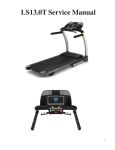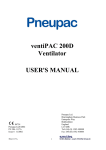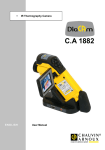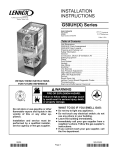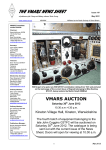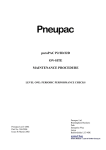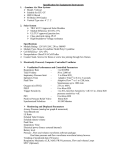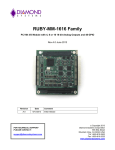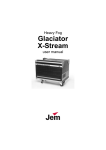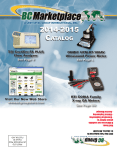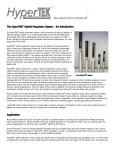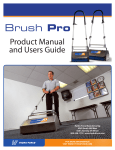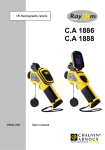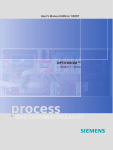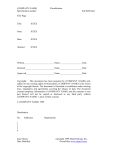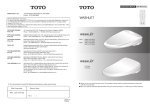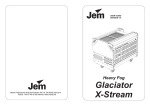Download MAG2200 Mod-2 OpsMan - Oceanic Medical Products
Transcript
1 Magellan-2200 Model 2 Anesthesia Machine Operators Manual CAUTION: Federal law restricts this device to be used by or on the order of a physician. Updated: 11.11.06 8005 Shannon Industrial Park Lane Atchison, Kansas 66002 Tel: 913 874 2000 Fax: 913 874 2005 [email protected] 2 TABLE OF CONTENTS PAGE SUBJECT • General Description 3 • Definition of Statements 3 • General Warnings 3 • Machine Specifications 3 • Functional and Operational Procedures 5 Assembly of Components 6 Pneupac® CompPAC™ Ventilator and Compressor 12 Pre-Use Checklist 28 Functional Operation of Controls and Accessories 31 Post-Use Checklist 36 • Cleaning, Disinfecting and Sterilization 37 • Minor Maintenance Recommendations 37 Tools Needed for Maintenance 37 • PROBLEM SOLVING GUIDE 38 • VACUUM MANIFOLD 38 • CYLINDER GAS DURATION FORMULA 39 • GAS FLOW DIAGRAMS 40 • ITEMS FURNISHED WITH EACH MACHINE AND PART NUMBERS 45 • ADDITIONAL ITEMS NEEDED FOR OPERATION AND MAINTENANCE 45 • BILL OF MATERIALS WITH PART NUMBERS 46 • EXPLODED DIAGRAMS OF MAJOR COMPONENTS 50 3 GENERAL DESCRIPTION The Magellan-2200 Anesthesia Machine is compact robust and flexible, easy to transport and was designed for military forward surgical teams, combat surgical hospitals, general civilian hospitals, outpatient surgical centers, office-based anesthesia, military and civilian veterinary medicine. 3. Gas Power Source - Ensure that adequate Oxygen and Compressed Medical Air pressure and volumes are available before engaging the ventilator power toggle switch to ensure proper operation of the ventilator. MACHINE SPECIFICATIONS DIMENSIONS The Magellan-2200 is completely pneumatically powered and is designed to be used with any complete or simple patient monitoring system that the operator prefers to use or has on hand. Height 23 inches Depth 23 inches The Magellan-2200 may be mounted on its custom-made carrying case, a mobile trolley especially designed for the unit, other mobile carts or on a tabletop as the operator prefers. Width 17 inches Factory Quality Assurance Testing Weight • Free-Standing • Enclosed in Carrying Case 45 lbs 130 lbs Each Magellan-2200 is tested several times during the manufacturing process. Final testing and calibration of components and the completed machine are recorded and a final functional test copy is included in the shipment from the factory to the initial customer. Machine Materials Aluminum, brass and plastic DEFINITION OF STATEMENTS Carrying Case Materials Plastic, military grade The following terminology and statements are important for the operator to understand before proceeding with the manual or operation of the Magellan-2200: Operating Temperature Range 35 degrees F to 110 degrees F Required Gas Supply Sources WARNINGS: indicate a possibility of injury to the operator or others CAUTIONS: indicate a possibility of damage to the equipment • O2 Main and Cylinders • Air and/or Air Compressor • Oxygen Concentrator 38 to 70 psi (50 psi is optimal) 38 to 70 psi (50 psi is optimal) 3 to 10 psi (For O2 Flowmeter only) NOTES: indicate points of interest for proper operation of the equipment Flowmeter Fresh Gas Flow 1 to above 20 lpm (each flowmeter) General Warnings: Oxygen Flush Valve Recessed, self-closing, push-button, color coded and labeled, provides 45-55 lpm constant flow, while push-button is depressed; may not be used with O2 concentrator as O2 power source CO2 Absorber System King Systems KAB-9 (re-fillable) or KAB-1 (pre-filled/disposable) CO2 Absorber Canister Capacity 400 grams soda lime Directional Valves Built in the CO2 Absorber 1. Patients requiring life-support equipment should be under the constant surveillance of competent medical practitioners. There is always the possibility of machine and alarm failure and some malfunctions require immediate, corrective action. 2. Vaporizer-Tilting the vaporizer past 45 degrees with liquid agent in the chamber can result in patient injury or death. If tilted past 45degrees, empty the chamber, fully open the percent control, then flush the vaporizer with Oxygen from the Oxygen flowmeter set to 5 lpm for 10 minutes. 4 Bag-Ventilator Switch/PRV and Scavenger Outlet Port Hand-operated selector switch and rotating knob for PRV and scavenging outlet Bellows Latex free, upward inflating, range from 0 to 1.6 L Bellows Pressure Relief Pre-set at 60 cmH2O Common Gas Outlet Tubing Circuit Vaporizer Penlon SigmaDelta Series, bolt (cage) mounted, temperature compensated, very low maintenance Airway Pressure Gauge Dual scaled in cmH2O and mmHg, located on front panel of ventilator Quick-connect, size indexed Pressure Gauge Tubing King Systems F-360-61 or any standard anesthesia circle circuit May be attached to bag/vent switch arm or to a point within the patient breathing circuit (operators choice). Mechanical Ventilator Pneumatically powered, time cycled, volume constant, flow variable • Ventilator Pressure Relief Pre-set to maximum of 60 cmH2O located in main vent box • Minute Volume Range 6 to 14 L • Insp. Flow Range 10 to 40 L/min • Frequency breaths per minute 10 to 30 • Exp. Ratio-Fixed 1:1.8 nominal Gas Pressure Hoses DISS and thread indexed, female connectors at both ends Gas Inlet Manifold DISS and thread indexed, male connectors with one-way valves Gas Inlet Manifold Filters Located behind Manifold Air and O2 inlet male connectors Gas Inlet Pressure Regulators • Main supply cylinder • Safety back up cylinder DISS/thread indexed for O2 Pin-indexed, yoke mounted for "D" and "E" cylinders for O2 Ventilator Gas Power Requirements 40 to 70 psi, 50 psi optimal Use toggle switch to select gas source Oxygen and Air Supply Gauges 0-3000 psi range, color coded and clearly labeled Waste Gas Scavenger Positive and negative relief valves, 1 L reservoir bag, vacuum control knob Pneumatically actuated when O2 supply falls below 30 psi Pneumatically actuated when O2 supply falls below 1 psi 9-volt battery located in body of alarm box Labeled toggle switch located on body of alarm box Total Machine Gas Leakage @ 30 cmH2O @ 80 cmH2O -0- ml/Min -0- ml/min Internal System Compliance @ 20 cmH2O @ 40 cmH2O 1.1 ml/cmH2O 1.3 ml/cmH2O Internal System Resistance @ 1.0 L/sec gas flow @ 0.5 L/sec gas flow 4.11 cmH2O 1.80 cmH2O APL Valve Pressure Drop @ 3.0 L/min gas flow @ 30 L/min gas flow 0.12 cmH2O 1.03 cmH2O + 160°F - 30°F Allow unit to warm to normal OR temp for 1hour Oxygen Supply Alarms • Main and safety back-up • O2 Concentrator • Alarm power source • Alarm on/off Air and O2 Flowmeters Calibrated and scaled 0-10 lpm, color coded, O2 flowmeter has a fluted control knob for easy identification by touch, alone Oxygen Concentrator To power O2 flowmeter only Air Compressor May be used to power ventilator and air flowmeter Oxygen Analyzer/Monitor OM-25-ME (or equivalent) Galvanic cell sensor, life expectancy 2 years under normal conditions Oxygen Analyzer Power Source 2 each AA batteries, life expectancy approx. 3000 use hours Storage • Indoor • Outdoor 5 FUNCTIONAL AND OPERATIONAL PROCEDURES The following procedures should be performed between the time the Magellan-2200 is assembled for use, actually used and post-use, to ensure proper assembly of components and operation. 1. Removal and Mounting of Machine Turn on side, open, remove lid 2. Remove machine; Turn open box so that wheels are down. 3. Review parts in lid of ventilator box. 4. Positioning of parts in lid of ventilator box. 5. Mount anesthesia machine to top of box, securing with mounting screws. 6. Reattach lid of box to front of box with machine mounted. 7. Attach small O2 cylinder mount to box back. 8. O2 cylinder mount completely attached. 6 ASSEMBLY OF COMPONENTS FOR USE OF THE MACHINE BACK OF MACHINE 3. Oxygen Hose: Main O2 Supply: Attach one end of the 15-foot green O2 high pressure hose to the top left O2 inlet connector on the Gas Manifold and the opposite end to the O2 source (either an O2 Cylinder or O2 Wall outlet.) 1. Pressure Reducing Regulator: Attach yoke-type pressure reducing regulator to the "D" or "E" Oxygen cylinder to be used for safety back-up purposes. 2. Oxygen Hose: Attach one end of the 24-inch green O2 high pressure hose to the outlet port of the pressure reducing regulator and the opposite end to the left-side of the Gas Manifold. 4. Oxygen Concentrator in Lieu of Main O2 Source: If an O2 Concentrator is to be used instead of cylinder or wall O2 sources, the tubing from the O2 concentrator should be connected to the specially labeled (O2 concentrator only) inlet nipple located above and to the right side of the Gas Manifold. 7 5. Water Trap: Attach the Water Trap to the Air inlet port on the GasManifold CAUTION: Do not attach the water trap to the outlet port of the Air Compressor as water may condense enroute to the anesthesia machine and cause possible malfunction of some of the components. 6. Air Hose: Attach one end of the 15' yellow Air high-pressure hose to the inlet port of the Water Trap. Attach the opposite end of the high pressure hose to the air compressor outlet port or to other Air sources (wall or cylinder) 7. Waste Gas Scavenger Tubing Connection: 1. Attach the waste gas scavenger to the upper right hand side of the back frame, using the Velcro strip or keyhole mounting, then attach the reservoir bag to bottom port of the scavenger. Attach suction source tubing to the inlet port of scavenger control knob port. NOTE: In military field conditions the reservoir bag to the bottom port of the scavenger may be replaced with a large bore hose to possibly evacuate waste anesthetic out of the work area. . WARNING: Scavenger system should always be mounted in order to keep debris from entering the bellows outlet port. 1. Attach one end of the first scavenger tubing to the scavenger outlet port of the B/V Switch labeled "to scavenger" and the opposite end to the "TEE" connector. 2. Attach one scavenger tubing, with the 19mm purple connector to the center port located on the base of the Bellows, and attach the other end to the "TEE" connector. 3. Attach the final scavenger tubing to the top of the Waste Gas Scavenger and the other end to the "TEE" connector. VENTILATOR SIDE OF MACHINE 1. CO2 Absorber Support Arm: Attach the CO2 Absorber Support Arm to the Main body of the machine by inserting the two pins of the Arm into the two holes provided-then screw in the knob-screw from the back side of the frame to secure the Arm. Ensure that the stem of the Arm is pointed upwards. 8 2. Bag-Vent Switch Assembly Arm: Attach the Bag/Vent Switch Assembly Arm to the top of the machine, using the dowel pin guide located under the top of the machine and insert the B/V Switch hole provided for the dowel pin. Secure the B/V Switch by inserting the knob-screw through the top of the machine. 9 3. Reservoir Bag: Attach the Reservoir bag to the chrome inlet port connector located on the bottom of the B/V Switch Arm. 4. Airway Pressure Gauge Tubing: Attach the Airway Pressure Gauge Tubing connector to the bottom of the B/V Switch Arm. 5. Gas Flow Tubing: Attach the semi-clear tubing from the Common Gas Outlet to the inlet connector of the CO2 absorber. NOTE: If the clear plastic connector (supplied with the CO2 canister is not available, the semi-clear tubing may be directly attached to the inlet port nipple of the CO2 canister. 10 6. CO2 Absorber Canister: Attach the CO2 Absorber Canister to the Absorber Support Arm. 10. Patient Tubing Circuit: Attach the preferred Patient Tubing Circuit to the CO2 Absorber inlet and outlet connecting points. BAG AND VENT ARM TUBING 7. Attach the RED labeled tubing to the outlet of the ventilator as shown on the label. Then attach the other end of the tubing to the ventilator inlet port of the bellows (far right port) using the 17mm connector. 8. Attach the GREEN labeled tubing to the brass outlet port of the B/V Switch and the opposite end to the bottom right connector ("L" shaped) located on the bottom-right position of the CO2Absorber. 9. Attach the BLUE labeled tubing to the right side inlet port of the Bellows (labeled blue) and the opposite end to the lower outlet port of the B/V Switch (labeled "To Bellows"). NOTE: Any patient tubing circuit approved for use with an anesthesia machine may be used. The factory supplies a King Systems F-360-61 circuit with each machine as it is initially shipped. 11 FRONT AND TOP OF ANESTHESIA MACHINE OXYGEN MONITOR ATTACHMENTS 3. Attach the O2 monitor O2 sensor into the blue O2 sensor bracket. 1. Attach the O2 monitor-mounting bracket to the right side support post. Insert the monitor into the slide bracket. CAUTION: Insure that the O2 monitor sensor is mounted into the sensor bracket facing upward for best performance and to keep any humidity from accumulating around the sensor. 2. Attach the blue O2 monitor sensor bracket into the Inspiratory outlet located on the left-hand side of the front of the CO2 absorber. 12 PNEUPAC® COMPPAC™ VENTILATOR AND COMPRESSOR USER’S INFORMATION 504-2107 3 Table of Contents SECTION 1 (a) Summary Statement (b) WARNINGS AND CAUTIONS (i)WARNINGS (ii) CAUTIONS Page 13 13 14 14 15 SECTION 2: GENERAL INFORMATION (a) Intended Use (b) Contraindications – None Known. (c) General Description (d) Ventilator and Compressor Controls, Indicators and Connections (Figure 1) (e) Accessories 16 16 16 16 16 20 SECTION 3: SET-UP, USE and FUNCTIONAL CHECK (a) Set-Up (i) comppac Ventilator (b) Functional Check 22 22 22 24 SECTION 4: OPERATION (a) User’s Skill (b) Setting of the Ventilator (i) General (ii) Ventilating the Patient 27 27 27 27 27 SECTION 5: CARE, CLEANING and STERILIZATION (a) Care (b) Battery Care (c) Cleaning (d) Sterilization (e) Assembly and Function Testing (f ) Decontamination 28 28 28 28 28 28 28 SECTION 6: MAINTENANCE (a) General (b) Performance Checking (c) Service (d) Compressor Reservoir Maintenance (e) Storage 29 29 29 29 29 30 Smiths Medical International Ltd. reserves the right to make changes, without notice, which may affect the information contained in this manual. Trademarks: The names “Pneupac”, “comppac”, “comppac” and “Smiths” are trademarks of Smith’s family of companies. 13 SECTION 1 (a) Summary Statement The comppac OEM ventilator is a gas powered automatic ventilator intended to provide ventilation during anesthesia, in a military field hospital, to adult and paediatric patients greater than 20 kg (44 lb). The comppac OEM ventilator comprises two separate cases, one case containing the ventilator that is fixed into an Oceanic Magellan 2200 portable anaesthetic machine and the other case containing the compressor which is free standing and provides air for both the ventilator and anaesthetic machine flowmeter. The primary role of the comppac OEM ventilator is to provide patient ventilation when fitted to the Oceanic Magellan 2200 Portable Anaesthesia Machine. It can be powered by compressor oxygen, compressed air or by an electrically operated compressor. The ventilator can be driven in various ways: i) Oxygen from a nominal 60psi supply which can be powered by; • Regulated compressed cylinder, or • Wall-mounted outlets ii) Air from a nominal 60psi supply which can be powered by: • Regulated compressed cylinder, or • Wall-mounted outlets iii) Internal compressor providing compressed, fresh air. This can be powered by: • internal 24V battery, or • external 24/28V d.c. supply, or • external 115V a.c. supply (via PS11 power supply), or • external 240V a.c. supply (via PS11 power supply) or PS 12 The comppac OEM ventilator comprises of the following standard kit parts: • Ventilator Module: Part No - 510A3053 (1) • Compressor Module: Part No – 510A3060 (2) • Rubber Boot: Part No – 510A2271 (3) • NBC Filter: Part No – W7265 (4) • Hose MA4 DISS to DISS: Part No – 500A4888 (5) • 24/28 volt open-ended Vehicle Supply lead to comppac: Part No – 510A3096 (6) • comppac ventilator / compressor User Manual: Part No – 504-2107 (Not shown) • Water trap Assembly: Part No – 510A3105 (7) • Interconnection cable: Part No – W288-001 (8) • Reservoir Cover Spares: Part No – 510A2956 (Not shown) • Sensing line: Part No – 510A3107 (9) • NiCad Battery: Part No – 510-A1490 (10) • Microbiological Filter: Part No – W8860 (11) 2 Graphical representation of electrical power source inputs, their relevant interfaces/ devices and outputs. To run the comppac: 2 PS 12 — Charging While Operating entilator V Figure 1: CompPac OEM System 14 The following labels are fitted on the ventilator module: • Ventilator Panel Label: Part No – 504-351 • Patient monitoring port identification label: Part No – 504-353A • Gas supply port identification label: Part No – 504-353B • Interconnection port identification label: Part No – 504-353C • Federal law label: Part No 504-1166NUS • Alarm Bezel Label (set of 2): Part No – 504-222 And the following fitted labels on the compressor module: • Compressor panel label: Part No - 504-352 • Battery fitting and removal instruction Label: Part No – 504-223 WARNING: Failure to read this user’s handbook before first use of this device may result in death or serious injury. WARNING: To avoid harm to the patient, pre-use checks must be performed in accordance with section 4 of this manual before each use. WARNING: Always ensure that an alternative means of ventilation is available in the event of ventilator failure or malfunction. All operators should receive a full and proper initial and ‘refresher’ instruction from a qualified person, both on resuscitation and on detailed use of the equipment in the particular situations in which it might be employed. WARNING: To avoid harm to the patient, this equipment should only be used by personnel trained in the use of automatic ventilation. Information given in this manual beyond the basic operation of the comppac ventilator is only intended as a guide to supplement proper training and to indicate the specific operational requirements of the comppac. The comppac ventilator is intended for use in anesthesia by users who are appropriately trained and where the patient is being constantly monitored. WARNING: Failure to constantly monitor the patient whilst using this equipment, may lead to death or serious injury. Although use of this ventilator outside the environmental conditions specified in this Manual will not directly lead to a safety hazard the performance will become increasingly uncertain as the conditions become more extreme. Therefore the operator must exercise constant patient vigilance under these conditions. WARNING: Blood gas levels must be monitored independently, correct operation of the ventilator will not necessarily achieve the required blood gas levels. Also, when used at moderate altitude, it is essential that the user closely monitors delivered tidal volume, and measures end-tidal CO2 using suitable capnography. (b) WARNINGS AND CAUTIONS (i) WARNINGS Warnings are given to make you aware of dangerous conditions, that could lead to death or serious injury to the user or patient, that can occur if you do not obey all of the instructions given in this manual. The following Warnings highlight aspects of the use of the comppac ventilator that require particular emphasis. The section of this manual referenced in each clause provides the relevant context: 1.WARNING: Failure to read this user’s handbook before first use of this device may result in death or serious injury (Section 1(a)). 2. WARNING: To avoid harm to the patient, pre-use checks must be performed in accordance with section 4 of this manual before each use (Sections 1a) & 3b)). 3. WARNING: Always ensure that an alternative means of ventilation is available in the event of ventilator failure or malfunction (Section 1a) & 4). 4. WARNING: To avoid harm to the patient, this equipment should only be used by personnel trained in the use of automatic ventilation (Sections 1(a), 3(a), 4(a), & 4g)). 5. WARNING: Failure to constantly monitor the patient whilst using this equipment, may lead to death or serious injury (Sections 1(a) & 4b)ii)). 6. WARNING: Blood gas levels must be monitored independently, correct operation of the ventilator will not necessarily achieve the required blood gas levels. Also, when used at moderate altitude, it is essential that the user closely monitors delivered tidal volume, and measures end-tidal CO2 using suitable capnography (Section 1(a)). 7. WARNING: To avoid the potential risk of explosion associated with re charging the Lithium version of battery, ensure that only a Ni Cad battery (Part No: 510-A1490/ CE, NATO No: 6140-99-620-8057) is installed. UNDER NO CIRCUMSTANCES SHOULD THE LITHIUM BATTERY (NATO No: 6135-99-840-0109), OR ANY OTHER PRIMARY BATTERY, BE FITTED. (Sections 2c), 2d) #14, 2d #15, 2e) iii), 3a), & 5b)). 8. WARNING: To avoid malfunction of the ventilator when using the battery as a power source, periodically check the battery to ensure that there is sufficient charge to power the ventilator. The battery may be trickle or fast charged using the PS11 power supply/ charger unit (see section 2e) iii), however, this should be undertaken in advance of use and, where necessary (ie: battery does not retain its charge), the battery may need replacing (Sections 2e ii) and 5b). 9. WARNING: To avoid the risk of fire or explosion or impaired ventilator performance, always observe the correct polarity of the auxiliary supply. Ensure the supply is a stable voltage from 23 to 30 volts capable of supplying 3 Amps (5 Amp surge on motor start) and does not contain excessive interference (Section 2e) iii). 10. WARNING: When in use in a contaminated atmosphere, to avoid the risk of harm to the patient, the NBC filter must be fitted (Section 2e iv)). 15 11. WARNING: To avoid the risk of electric shock, when using the comppac ventilator in conjunction with the Power Supply/ Charger, the Power Supply/ Charger should be located outside the patient environment (ie: ≥ 1.5 Metres from the patient) (Section 2d) #15 and 3a) ). 12. WARNING: Switching on the ventilator before the compressor reservoir pressure reaches 50 psi as indicated on the anaesthetic machine air pressure gauge may cause the gas failure indicator to malfunction. To avoid this always allow compressor reservoir pressure to build up to 50 psi before switching on ventilator (Section 3b) and 4). 13. WARNING: When running the ventilator from the compressor, rapid extreme changes in temperature and humidity may cause the ventilator to malfunction (Section 3b) and 4). 14. WARNING: Setting the anaesthetic machine air flowmeter above 2L/min may cause an excessive drop in compressor reservoir pressure with a subsequent drop in ventilation performance (Section 3b) and 4). 15. WARNING: Deviations noted at the functional check should be reported immediately and the unit must be taken out of service to avoid the risk of death or serious injury (Sections 3b)#9 & 6b). 16. WARNING: To avoid the risk of chemical / environmental hazards, disposal of a contaminated/ used NBC filter must be in accordance with local regulations (Section 3b #11). 17. WARNING: To avoid the risk of over inflation of the patient it is important for the operator to constantly monitor the patient pressure manometer during manual ventilation (Section 4). 18. WARNING: To avoid the risk of cross contamination all re usable components in the patient circuit, that can come into contact with the patient or the patient’s exhaled gas (Patient Valve and Patient Hoses) should be sterilized or disinfected as per instructions detailed in Sections 5d) and 5e) of this user manual. The sterilization process will also minimize the risk of contaminating the patient with Legionella, which can found in some hospital hot water reservoirs. 19. WARNING: Failure to use approved circuits and accessories may lead to unsatisfactory ventilator performance (Section 7). 20. WARNING: To avoid the risk of harm to the patient from an incorrectly set ventilator, servicing or adjustment of this equipment should only be carried out by competent personnel who have been trained by Smiths Medical International Ltd. to carry out such work (Section 6c). 21. WARNING: Extreme environments may impair ventilator performance, operator vigilance is required to monitor the patient. 22. WARNING: To avoid the risk of under inflation of the patient, it is important for the operator to monitor tidal volumes. This is especially important iwth a combination of ventilator minute volume settings of 12L and above, power supply voltages below 24 Vdc and patients with low compliance lungs and highly restrictive airways. (ii) CAUTIONS Cautions warn of dangerous conditions that can occur and cause damage to the ventilator or its accessories, if you do not obey all of the instructions given in this manual: 1. CAUTION: It is recommended that the comppac ventilator is only used with a battery installed, even if the ventilator is being powered by gas only, as the battery is used to power the electronic alarm system. The ventilator will work without a battery or external electrical supply, since it operates as a conventional gas powered device with the patient protection devices and the high inflation pressure pneumatic alarm operating normally. However, the user must be aware that in these circumstances, the electrically operated alarms will NOT function. (Section 2e). 2. CAUTION: To avoid accidental disconnection of the power supply unit (PS11) when it is connected to the comppac OEM unit, the power supply mains lead should always be locked in position. (Section 2e). 3. CAUTION: Avoid fast charging batteries outside the temperature range of +10ºC to +30ºC. The batteries will not accept a full charge outside this range and, in certain circumstances, the capacity of the battery may be permanently impaired. At low temperature, the electrolyte may be electrolysed, and small quantities of hydrogen released, which in extreme circumstances present an explosive risk. (Section 2e). 4. CAUTION: The protective bung fitted to the NBC Filter should always be removed before fitting it to the comppac ventilator (Sections 2e) & 3b) #11). 5. CAUTION: Excessive ingress of moisture could result in deterioration of internal components, if the device is unlikely to be used regularly (ie more than once a week). This could also result in the ventilator failing to start. To avoid this, ensure that the comppac compressor unit is properly dried after each use. The comppac ventilator must be dried internally as detailed in Section 5 a) iv), powered by the compressor alone (i.e. delivering 21% oxygen) (Section 5ea). SECTION 2: GENERAL INFORMATION (a) Intended Use The comppac OEM ventilator is a gas powered automatic ventilator intended to provide ventilation during anesthesia, in a military field hospital, to adult and pediatric patients greater than 20 kg (44lbs). The comppac OEM ventilator comprises two separate cases, one case containing the ventilator that is fixed into an Oceanic Magellan 2200 portable anaesthetic machine and the other case containing the compressor, which is free standing and provides air for both the ventilator and anaesthetic machine flowmeter. It has been designed to function using a NATO approved NBC filter (NATO No: 4240-21912-5397), and is therefore suitable for use in chemically laden environments that are likely to be encountered on the battlefield. It can be operated from a range of power sources to provide maximum flexibility of operation in remote areas, in military campaigns and in disaster relief. It is suitable for ventilating adults and children (above 20 kg). The comppac ventilator and associated equipment described in this manual conform to ASTM F1101– 90 Standard specification for ventilators intended for use during anesthesia. (b) Contraindications – None Known. (c) General Description The comppac COM OEM ventilator is gas powered and is housed in an enclosure designed to fit into the Oceanic Magellan 2200 portable anesthesia machine. The separate compressor housing is designed to accept the long endurance battery that is used to drive a small compressor, which in turn provides compressed air, to power the ventilator and up to 2 L/min for the anesthesia flow head fresh gas mix. All ambient air via the compressor for the fresh gas mix from the anesthesia machine passes into the system through a standard *NBC filter. About 1/3 of the volume is compressed to drive the ventilator before expansion in an entrainmentmixing device, which entrains the other 2/3 by creating a sub-atmospheric pressure. This entrained gas is not filtered through the NBC filter since the ventilator gas is separated from patient gas by the anesthesia machine bellows. The NiCad rechargeable battery specified for fitting inside the unit will provide approximately 2 hours continuous ventilation (also dependent on the ventilator setting during use). The compressor has an external straight bayonet push-pull type connection on the front panel. This enables the system to be used for extended periods wherever a 24-28V d.c. supply is available. The power requirement is less than 50 watts. If the power supply is connected to this socket, simultaneous trickle charging of internal battery will occur whilst the ventilator is running. WARNING: To avoid the potential risk of explosion associated with re charging the Lithium version of battery, ensure that only a Ni Cad battery (Part No: 510-A1490/CE, NATO No: 6140-99-620-8057) is installed. UNDER NO CIRCUMSTANCES SHOULD THE LITHIUM BATTERY (NATO No: 6135-99-840-0109), OR ANY OTHER PRIMARY BATTERY, BE FITTED. 16 An input gas pipe is provided to allow the comppac ventilator to be connected to a 280 to 600 kPa gas supply from the Oceanic Magellan 2200 anesthesia machine so that it can be operated independently of the compressor module. In this way, if oxygen or air cylinders or liquidoxygen are available, this can be used to power the ventilator and the internal battery can be conserved. Calibrated controls for frequency and minute volume are provided to set the required ventilation pattern. A fixed pressure relief device limits the peak inspiratory pressure and provides a pneumatically operated audible high-pressure alarm. In addition an electronic high-pressure alarm sounds if the inflation pressure exceeds 60 x100Pa (60 cm H2O). There is negligible interdependence of these controls. All controls and indicators are mounted on the front panel. The layout is shown on Figure 1. The electronic alarm unit not only gives warning of high inflation pressure but also of patient circuit disconnection, failure to cycle and low voltage. It is powered from the internal battery within the compressor module and will operate even if the battery power is too low to operate the compressor. The interconnection cable must be connected between the ventilator and the compressor in order for the electronic alarms to function. There is no specific control switch on the alarm system. With the main battery and interconnection cable in place it is energised automatically whenever the ventilator is operated by switching the compressor on or by the application of gas pressure to the auxiliary connection. The alarm is turned off by removing the gas supply if an external source is being used or by returning the compressor on - off switch to “OFF”. The comppac ventilator module is connected to the Magellan 2200 bellows by means of a corrugated hose and remote patient valve. (d) Ventilator and Compressor Controls, Indicators and Connections (Figure 1) 1. Minute Volume Control (See Figure 1) This calibrated rotary control knob gives continuous adjustment of the minute volume delivered to the patient over the range 6 to 14 L/min. 2. Frequency Control (See Figure 1) This rotary control knob gives continuous adjustment of frequency over the range 10 to 30 breaths per minute. The I:E ratio is nominally constant at 1:1.8 throughout the range of frequency. 3. Patient monitoring port The ventilator electronic alarm sensors and inflation pressure monitor connect to the Magellan-2200 absorber manifold via the disposable filter and pipe assembly. 4. Pressure Relief Valve (See Figure 1) The relief valve is connected inside the ventilator direcly into the ventilator circuit and protects the patient from being delivered pressures in excess of the set level. Note : Cycling pressure will be up to that set by the pressure relief valve. 17 upon airway restriction and/or lung compliance.. A fixed or adjustable relief valve set at 60 cm H2O may be fitted to the comppac ventilator. If there is a battery in place, or an external electrical supply is connected, the independent electronically operated high-pressure alarm will sound whenever the inflation pressure exceeds 60 x100Pa (60 cm H2O). (See Section 2d #7) The fixed relief valve can be unscrewed from the control panel but this is only advised for cleaning and maintenance. Always use the wings on the body of the valve for tightening and untightening. Figure 1: Controls, Indicators and Connectors 5. Inflation Pressure Monitor (See Figure 1) This pressure manometer displays the patient inflation pressure, as measured at the ventilator outlet. It will give an accurate indication of the actual patient proximal inflation pressure under all normal settings of the ventilator. 6. Supply Gas Failure (See Figure 1) This mechanically operated visual alarm gives a warning that the supply gas has dropped to a pressure at which the ventilator will no longer be operating to specification if operating from a compressed gas supply. With low pressure it shows red, with adequate pressure it shows white. Any visible red indicates that the supply should be changed. In most cases the display will begin to oscillate from white to partial red as the supply pressure falls to the low threshold level. The visual indication will be accompanied by an electronically generated medium priority1* audible warning. In order to conserve the battery, if this audible alarm is ignored for more than 60 seconds the alarm system will ultimately switch itself off. 7. High Inflation Pressure Alarm (See Figure 1) In addition to the audible alarm described in Section 2(d)#4 an independent electronically generated audible and visual alarm is provided which operates when the inflation pressure rises above 60 cm H2O irrespective of the setting or operation of the relief valve. The electronic audible alarm only sounds after the alarm pressure has been maintained for a period of one second in order to avoid the sounding of the alarm during 1* See section 10(e) for explanation of symbols and description of alarm priorities 18 transient pressure events. Initially the visual alarm only indicates each time the pressure exceeds the preset limit but if high pressure conditions persist the alarm latches to give continuous flashing. Both audible and visual pressure alarms reset automatically after 10 seconds when the condition is no longer present. 8. Cycle Indicator (See Figure 1) During ventilation of the patient the inflation pressure is continuously monitored by a positive pressure detector pre-set to 8 x100Pa (8 cm H2O). Each time the inflation pressure rises through this set pressure level the green Cycle Indicator flashes for 1/10 second to indicate to the user that, at the least, this inflation pressure is being achieved each cycle. 9. Low Inflation Pressure (Disconnect) Alarm (See Figure 1) A medium priority†audible and visual alarm will operate to warn the user of a possible disconnection in the ventilator breathing system, or that the ventilator is not cycling correctly, if the inflation pressure generated by the ventilator does not rise through the pre-set level of 8 x100Pa (8 cm H2O) at least once in any 10 second period. Both the audible and visual alarms reset when the alarm condition no longer exists. 10. Silencing of Electronic Audible Alarms (See Figure 1) A visual signal, consisting of an orange light flashing every 3 seconds, is used to indicate when an electronically generated audible alarm has been silenced. For the first 60 seconds after switching on the ventilator all alarms except the supply gas failure alarm, are automatically suspended although high priority visual alarms will still operate. Any audible alarm can be silenced for a 60 second period, subsequently, by depressing the silencing button but if a new alarm condition occurs during this period it will be immediately annunciated. If the silencing button is depressed pre-emptively, i.e. before any alarm sounds, then only a new high priority alarm condition will cause an alarm to sound during the following 60 seconds. 11. Patient Outlet Connection (See Figure 1) – GAS OUTPUT This outlet to the bellows from the ventilator is intended for the attachment of the patient circuit supplied by Oceanic Medical products Inc. for the purpose. 12. Gas Input Connector (See Figure 1) – DRIVING GAS INPUT This pipe is used to connect to the Oceanic Magellan 2200 anesthesia machine in order to supply gas power to the comppac. This gas may be air or oxygen selected by the ventilator power switch on the Magellan 2200. NOTE: The use of dry compressed gas is the preferred method of driving the comppac. Any other gas source supplying the ventilator via the Magellan 2200 should be at 305-600 kPa (44-87 psi) and be capable of supplying 13 litres/min at this pressure. 13 Electrical Power level Indicator (See Figure 1) A yellow visual indicator is used to indicate the state of the electrical power supplies to the ventilator. When the internal battery has been selected as the power source or when a gas supply has been connected, the absence of any signal from this indicator, coupled with normal operation by the alarm system indicators, confirms the internal battery is providing adequate voltage. When the alarm system detects that the battery charge has dropped to the level where approximately several minutes running time remains the yellow power indicator will commence to flash once every 30 seconds to give advanced warning of battery failure. As the charge reaches the point where it can no longer ensure full performance of the ventilator the flashing rate of the power indicator will increase to twice every second, accompanied by a medium priority* audible alarm. Although the ventilator may continue to operate whilst the battery failure alarm is annunciating, ventilator operation will become increasingly uncertain and damage may be caused to the battery. When an external electrical power source has been selected to power the ventilator and the internal battery is installed and charged then, again, absence of any signal from the power indicator, coupled with normal operation of the alarm system indicators, confirms that both the external supply and internal battery are providing adequate voltage for correct ventilation operation. With an adequate external power supply and no internal battery, or a discharged battery, the yellow power indicator will be constantly illuminated. A drop in voltage of the external power supply will be indicated by the indicator flashing off once every 30 seconds. If the supply voltage drops to the level where correct ventilator operation cannot be assured the power indicator flashes off twice a second and this is accompanied by a medium priority* audible alarm. If the compressor module is used to supply the compressed air, the supplied 1.5m hose and water trap must be fitted between the compressor module and Magellan 2200 air supply manifold and the interconnection cable fitted between the compressor module and the ventilator module. † See section 10(e) for explanation of symbols and description of alarm priorities. * See section 10(e) for explanation of symbols and description of alarm priorities. 19 14. Cable disconnect alarm Test Switch (See Figure 1) The Cable disconnect alarm Test switch is used to test the function of the cable disconnect alarm which is housed within the compressor module. When the switch is depressed the alarm sounder should sound continuously. The function of the electronic alarm system is totally dependant upon correct connection of the interconnection cable between the compressor module and the ventilator. For this reason the cable disconnect alarm should sound when the cable connection has become compromised by accidental disconnection or damage. 20. NBC Canister Adaptor (Not Shown) This threaded adaptor is to a standard military specification for the connection of NBC filters. The filter should always be screwed in fully so that it seals against the sealing washer at the base of the adaptor thread. The comppac should not be operated without a filter; other than its obvious need when protecting the patient’s air supply; its presence ensures that dust and dirt do not enter the patient circuit, valves and other internal sensitive areas. 15. Compressor ON / OFF (I / O) Switch (See Fig. 1) When the ventilator is connected to the compressor module via the interconnection cable, the compressor and electronic alarms are activated by switching this switch to the I position. Please note that to prevent accidental switching, the switch has to be pulled out before changing state from 0 (off) to I (on) and vice-versa. Switching this switch to the 0 position stops the compressor. This will also stop the alarms after 60 seconds providing no other gas source is switched to the ventilator. 16. Compressor power indicator LED‘s External Power for Compressor and Battery Power for Compressor When the compressor is switched on, the most appropriate power supply is selected automatically depending on if the internal battery is fitted, if an external electrical supply is fitted and the level of the electrical power available. The green LED is illuminated when the system has automatically chosen an external electrical supply to run the compressor. The yellow LED is illuminated when the system has automatically chosen the battery to run the compressor. Note: Power for the alarm system is taken from the battery by default unless no battery is fitted or the battery is discharged. 17. Interconnection Port The Interconnection port has a high density Female 15 pin D connector which will accept a screened high performance SVGA monitor to PC cable. A box type bracket surrounds the connector to provide support for the cable connector and provide protection to the connection from excessive strain. The cable can be locked in place using the two screws normally provided on the cable assembly. 18. Compressor Gas Output The compressor gas output is fitted with a DISS Air type connector. 19. External Electrical Input Connector The electrical input connector is a push – pull bayonet type. A red dot on the connector must line up with the red dot on the cable plug and the connection is made by pushing the cable plug into the connector. The plug will be locked in place until the collar of the plug is pulled away from the connector. Figure 2e —Battery Removed.Also refer to figure 6, installation is the reverse of removal Figure 2 (See also Figure 4): Removal of the Battery (installation is reverse) 20 • (e) Accessories (i) Batteries The comppac ventilator is designed to operate from the NiCad rechargeable version of a widely stocked military 24V battery which was originally introduced to power the “Clansman” communications pack; NATO No. 6140 - 99 - 620 - 8057. It is packaged in either a plastic or metal casing but the comppac ventilator only accepts the plastic casing - there are wider fixing lugs on the metal casing. The Ni-Cad battery has an 85ºC internal thermal cut out. WARNING: To avoid malfunction of the ventilator when using the battery as a power source, periodically check the battery to ensure that there is sufficient charge to power the ventilator. The battery using the power supply/charger unit (see section 2e) iii), however, this should be undertaken in advance of use and, where necessary (ie: battery does not retain its charge), the battery may need replacing. This battery needs to be recharged within a month before use. Battery life will depend on ventilator settings, the table below shows typical battery duration for given settings: The batteries are field exchangeable. CAUTION: It is recommended that the comppac ventilator is only used with a battery installed, even if the ventilator is being powered by gas only, as the battery is used to power the electronic alarm system. The ventilator will work without a battery or external electrical supply, since it operates as a conventional gas powered device with the patient protection devices and the high inflation pressure pneumatic alarm operating normally. However, the user must be aware that in these circumstances, the electrically operated alarms will NOT function. (ii) Power Supply/Charger WARNING: To avoid the potential risk of explosion associated with re charging the Lithium version of battery, ensure that only a Ni Cad battery (Part No: 510-A1490/CE, NATO No: 6140-99-620-8057) is installed. UNDER NO CIRCUMSTANCES SHOULD THE LITHIUM BATTERY (NATO No: 6135-99-840-0109), OR ANY OTHER PRIMARY BATTERY BE FITTED. The Main Power Supply/Charging Unit is specially designed for use with the comppac ventilator. It will accept leads for connection to supplies of 200/250V 50Hz, 100/120V 60Hz or 24/28V d.c. respectively. One of two different Power supply/Charging units may be supplied with the system depending upon the date of manufacture. Earlier units may have a PS11 Power supply/Charging unit & later units will have a PS12 Power supply/Charging unit. Each unit has a separate user manual: •User Manual 504-2084NUS for the PS 11 (Part Number 510-2408) Power supply/Charging unit •User Manual 504-2109 for the PS12 (Part Number 535A1034) Power supply/Charging unit WARNING: To avoid the risk of fire or explosion or impaired ventilator performance, always observe the correct polarity of the auxiliary supply. Ensure the supply is a stable voltage of between 23 to 30 Volts capable of supplying 3 Amps (5 Amp surge on motor start) and does not contain excessive interference. Plug-in supply leads can be supplied to suit most mains outlet sockets used World-wide. CAUTION: To avoid accidental disconnection of the power supply unit (PS11) when it is connected to the comppac OEM unit, the mains lead should always be locked in position. CAUTION: Avoid fast charging batteries outside the temperature range of +10ºC to +30ºC. The batteries will not accept a full charge outside this range and, in certain circumstances, the capacity of the battery may be permanently impaired. At low temperature, the electrolyte may be electrolysed, and small quantities of hydrogen liberated, which in extreme circumstances present an explosive risk. An auxiliary power supply lead, part number 510A2582, is available from Smiths Medical International Ltd. to which the user can fit specific connectors to suit alternative 24/28V d.c. power supplies. This lead has only a single circuit so simultaneous battery charging will not occur with its use. (iii) NBC Filter WARNING: When in use in a contaminated atmosphere, to avoid the risk of harm to the patient, the NBC filter must be fitted. The comppac ventilator is designed to accept any NBC filter with a NATO Stanag 4155 thread, in order to filter NBC contaminants from gas being drawn from the atmosphere for supply to the patient. The selection and usage of a suitable filter for a particular environment must be the judgement of a person trained in the use of such a filter but, in principle, the criteria for selection, use and replacement will be identical to those which would be appropriate to protect the spontaneous breathing of the rescuer. Smiths Medical International Ltd. can supply Avon L12A1 NBC Filter Canisters which are registered as NATO No. 4240 – 99 – 132 – 0941. 21 CAUTION: The protective bung fitted to the NBC Filter should always be removed before fitting it to the comppac ventilator. For use in non-NBC environments it is recommended that the Avon L12A1 filter is always used to act as a dust/particle filter. It will also act as a silencer. For non-NBC use the filter only need be replaced at service intervals, and then only if it has been in normal emergency use. (iv) Drive Gas Supply Hose As standard Air Gas Supply Hose is provided in order to supply the anaesthetic machine and ventilator with compressed air from the compressor. This hose has a DISS Air connector on either end. 22 SECTION 3: SET-UP, USE and FUNCTIONAL CHECK (a) Set Up (i) comppac Ventilator Unpack the comppac ventilator and its accessories and check all items against the contents checklist. If any items are missing or incorrect, or have become damaged, notify your supplier immediately. WARNING: To avoid the risk of electric shock, when using the comppac ventilator in conjunction with the PS11 Power Supply/ Charger, the PS11 should be located outside the patient environment (ie: ≥1.5 Metres from the patient). WARNING: To avoid harm to the patient, this equipment should only be used by personnel trained in the use of automatic ventilation. If a new NiCad battery is supplied it will need to be charged initially for 14 hours using the PS11 Mains Power Supply with the recharging lead connected to the battery terminals by means of the dedicated Charger to Battery recharging lead Pt. No: 510A2422. WARNING: To avoid the potential risk of explosion associated with recharging the Lithium version of battery, ensure that only a Ni Cad battery (Part No: 510-A1490/CE, NATO No: 6140-99-620-8057) is installed. UNDER NO CIRCUMSTANCES SHOULD THE LITHIUM BATTERY (NATO No: 6135-99-840-0109), OR ANY OTHER PRIMARY BATTERY BE FITTED. After charging the battery install in accordance with the instructions shown on the upper face of the rubber boot, when removed from the comppac which are reproduced in Fig. 4. Fit an NBC filter canister to the compressor by means of the specially threaded adapter in the recess of the rear face. Screw it in fully until sealing contact is made with the sealing washer at the internal base of the adapter. The anaesthetic machine bellows unit can be screwed to the top of the ventilator enclosure using the four screws provided with the bellows unit without removing the lid from the ventilator enclosure. The top lid of the ventilator enclosure is fitted with clinch nuts to accept the bellows unit screws. The ventilator and bellows unit should be fitted into place on the Anaesthetic machine frame and secured with a single countersunk screw through the bottom plate of the machine frame and two screws through the back plate. Before securing the ventilator in place, connect the gas supply pipe to the ventilator supply port on the anaesthetic machine. Fit an in-line biological filter to the patient monitoring port luer lock connector and fit the sensing line assembly between the filter and the anaesthetic machine absorber manifold. Interconnect the compressor to the ventilator as follows: Fit one end of the interconnection cable into the strain relief bracket on the compressor frontpanel to mate with the interconnection port. Check for orientation of the D shape connector. Orientation guidance is provided by the interconnection port label. Screw in the screws on the cable to make connection secure. Fit the other end of the interconnection cable into the strain relief bracket on the rear of the ventilator to mate with the interconnection port. Again, check for orientation by referring to label. Screw in the screws on the cable to make connection secure. 23 MAGELLAN-2200 MODEL 2 MACHINE, AIR COMPRESSOR AND POWER SUPPLY – BACK VIEW 24 3. Set the ventilator controls as follows a. Compressor power switch: Off b. Frequency: 13 b/min (detent position) c. Minute Volume 12 L/min WARNING: Setting the anaesthetic machine air flowmeter above 2L/min may cause an excessive drop in compressor reservoir pressure with a subsequent drop ventilation performance. If using the compressor to provide the air gas power to the anaesthetic machine and ventilator fit the 2m gas supply hose between the compressor and the anaesthetic machine inlet manifold. Connect the ventilator to the bellows unit using the red colored hose supplied with the anaesthetic machine, the patient valve and 22 mm female to 15 mm male taper adaptor supplied with the compPAC ventilator. Note: A 90º patient 22mm male/female elbow connector may be fitted between the ventilator output port and the hose for ease of use. NOTE: If the ventilator output hose is incorrectly, connected to the ventilator, it will not deliver tidal volumes and the alarm may not sound during the functional occlusion test (See Section 3(b), 4(b)(ii) and 4(g)(iii) 5). (b) Functional Check WARNING: To avoid harm to the patient, pre-use checks must be performed in accordance with section 4 of this manual before each use. WARNING: Switching on the ventilator before the compressor reservoir pressure reaches 50 psi as indicated on the anaesthetic machine air pressure gauge may cause the gas failure indicator to malfunction. To avoid this always allow compressor reservoir pressure to build up to 50 psi before switching on ventilator. WARNING: When running the ventilator from the compressor, rapid extreme changes in temperature & humidity may cause the ventilator to malfunction. The following procedure should be followed when first setting up the ventilator to check that it has been assembled correctly and is operating safely. It should be repeated periodically as specified under ‘Maintenance’. 1. Set up the anaesthetic machine in accordance with the Oceanic Magellan 2200 user manual. Connect a test lung or adult re-breathing bag to the patient connection port. 2. Install and set up the ventilator as in section 3 (a) with a fully charged battery installed in compressor. 4. Set the Anaesthetic machine as follows: a. Air flowmeter: Closed b. Ventilator power switch: Off c. PRV valve: Closed 5. Switch on the compressor using the switch of the front of the ventilator and the ventilator alarms and compressor should start in the following sequence: a. The cable disconnect/battery back up sounder located in the compressor should beep once b. The ventilator alarm LED‘s should illuminate in a clockwise sequence starting from the low power LED. The disconnect LED will not illuminate during this sequence with the ventilator switch set to ‘Off’. The illumination of LED’s will be followed by a single beeo of the cable disconnect sounder. c. The battery power for compressor LED should illuminate at the same time. d. The compressor motor should start and run at high speed as long as the compressor reservoir is below 44psi. If the reservoir presser is above 44psi, the compressor will not re-start until the pressure has dropped to 44psi. e. The compressor motor should start and run at high speed. f. The disconnect LED and the silence LED should both flash initially. The silence LED should stop flahing after one minute of operation. 6. Adjust the anaesthetic machine air flowmeter to a flow of 2L/min and allow the bellows to fill-up fully. The compressor motor may slow down during filling the bellows indicated by a change in motor sound but this is normal. 7. The sounder in the compressor should beep every 15 seconds to indicate that the compressor is running on back up battery power. 8. Push the test cable disconnect alarm button. While the button is depressed a continuous alarm should sound. This tests the function of the cable disconnect alarm. 9. When the bellows have been fully filled and the air pressure is above 50 psi, switch on the ventilator by switching the anaesthetic machine ventilator power switch to “Air”. 10. The ventilator should cycle and power the bellows with a breath of approximately 900 mls. The green cycle LED should illuminate every breath providing the peak proximal pressure is above10 cm H2O. Check over several breaths. 11. Disconnect the patient port from the re-breathing bag or test lung and block the patient port. The relief valve alarm should operate and sound during the inspiration cycle. The manometer should give a reading of 60 cm H2O This may be accompanied by the ventilator high pressure LED flashing and alarm sounding. 12. Unblock the patient port & the bellows should be driven down to completely empty. Again the relief valve alarm should operate and sound during the inspiration cycle. This should be accompanied by the ventilator disconnect LED flashing and alarm sounding. 13. Switch off the compressor. The compressor should stop but the ventilator alarms should carry on functioning for 60 seconds before shutting down. NOTE: Short runs using the comppac compressor should be kept to a minimum in order to minimize the requirement to dry the unit after use. Finally, set the controls as specified in step 1 so the ventilator is left set for emergency use. WARNING: Deviations noted at functional check should be reported immediately to the manufacturer. and the unit must be taken out of service to avoid the risk of death or serious injury. 14. Battery Replacement. If the battery needs replacing follow the instructions shown on label Part Number 504-223, located on the inside face of the rubber boot, which is reproduced in Figure 4 on next page. 15. NBC Filter Replacement WARNING: To avoid the risk of chemical / environmental hazards, disposal of a contaminated /used NBC filter must be in accordance with local regulations. CAUTION: The protective bung fitted to the NBC Filter should always be removed before fitting it to the comppac ventilator. The ventilator should always be run with a NBC filter in place as this reduces the operating noise as well as filtering the air entering the compressor. Other than the protection provided to the patient’s air supply, the filter also prevents ingress of dust and dirt into the ventilator circuit, which could cause deterioration of ventilator performance. I 25 26 SECTION 4: OPERATION WARNING: To avoid the risk of over inflation of the patient it is important for the operator to constantly monitor the patient pressure manometer during manual ventilation. WARNING: Always ensure that an alternative means of ventilation is available in the event of ventilator failure or malfunction. (a) User’s Skill The comppac ventilator is designed to be used by medically qualified personnel. All potential users should familiarise themselves with the machine and its operation to enable them to use it effectively. They should study the contents of this manual to the extent required by their training. WARNING: To avoid harm to the patient, this equipment should only be used by personnel trained in the use of automatic ventilation. (b) Setting of the Ventilator (i) General The ventilator should be left with the controls set in the position specified in the functional check (Section 3(b)1) to enable it to be brought into use with a minimum of re-adjustment. Where the comppac ventilator is likely to be used away from gas sources it should be stored with a fully charged known good battery and/or connection leads for use with an outside power source. (ii) Ventilating the Patient (Pre-Use Checks) WARNING: Switching on the ventilator before the compressor reservoir pressure reaches 50 psi as indicated on the anaesthetic machine air pressure gauge may cause the gas failure indicator to malfunction. To avoid this always allow compressor reservoir pressure to build up to 50 psi before switching on ventilator. WARNING: When running the ventilator from the compressor, rapid extreme changes in temperature & humidity may cause the ventilator to malfunction. 1. Set up the anaesthetic machine in accordance with the Oceanic Magellan 2200 user manual. Connect a test lung or adult re-breathing bag to the patient connection port. 2. Ensure that the ventilator is installed and set up as in Section 3(a) with a fully charged battery installed in compressor. 3. Set the ventilator controls as follows: the Minute Volume, Frequency, Tidal Volume Conversion table will assist the operator in selecting the appropirate intial control setting. a. Compressor power switch: Off b. Frequency: To suit patient c. Minute volume: To suit patient WARNING: Setting the anaesthetic machine air flowmeter above 2L/min may cause an excessive drop in compressor reservoir pressure with a subsequent drop ventilation performance. 4. Set the anaesthetic machine as follows: a. Air flowmeter: Closed b. Ventilator power switch: Off c. PRV valve: Closed 5. Where a suitable gas source is available connect the gas supply hose between the anaesthetic machine and the gas supply. Turn on the supply (if relevant). 6. Adjust the anaesthetic machine flowmeters to provide fresh gas of approx 5L/min and allow the bellows to fill up fully. 7. Push the test cable disconnect alarm button. While the button is depressed a continuous alarm should sound. This tests the function of the cable disconnect alarm. 8. When the bellows have been fully filled and the gas pressure to drive the ventilator is above 50 psi, switch on the ventilator by selecting Air or oxygen as appropriate with the ventilator power switch on the anaesthetic machine. 9. The ventilator alarms should start in the following sequence: a. The ventilator alarm LED‘s should illuminate in a clockwise sequence starting from the low power LED. A single burst of the ventilator high priority audible alarm is given at the same time. b. The silence LED should flash for one minute of operation. This allows for possible disconnection during setting up. c. Set the ventilation parameters to suit the patient. 10. The ventilator should cycle and power the bellows. The tidal volume being dependant upon the ventilator settings. The green cycle LED should illuminate every breath providing the peak proximal pressure is above 10 cm H2O. 27 11. If the airway is very restrictive and or the lung is very stiff or the airway is blocked the relief valve alarm should operate and sound during the inspiration cycle. The manometer should give a reading of 60 cm H2O. This may be accompanied by the ventilator high pressure LED flashing and alarm sounding. 12. If the patient hose becomes disconnected the bellows will be driven down to completely empty. The relief valve alarm should operate and sound during the inspiration cycle. This should be accompanied by the ventilator disconnect LED flashing and alarm sounding. 13. When the ventilator is switched off, the ventilator alarms should carry on functioning for 60 seconds before shutting down. 14. If the compressor is required to power the ventilator and provide air to the anaesthetic machine follow the instructions given in the functional check. WARNING: Failure to constantly monitor the patient whilst using this equipment, may lead to death or serious injury. The Inflation Pressure Monitor should be kept under constant observation so that adverse ventilation conditions can be detected and corrected before the patient is put at risk. If the pressure jumps excessively at the commencement of inspiration an airway obstruction is indicated and this must be rectified. If the airway is clear the flow rate may be too high and this is reduced by decreasing the minute volume setting. Excessive pressure at the end of inspiration indicates a high tidal volume. This may be reduced by either reducing the minute volume or increasing the frequency. If the inflation pressure is too low, firstly check for leaks, secondly check the ventilation parameters, thirdly, check the patient valve for proper functioning. NOTE: At all times check the adequacy of the gas source or the power supply/battery as indicated by the electrical power indicator. 28 SECTION 5: CARE, CLEANING AND STERILIZATION (a) Care The compPAC ventilator is chemically hardened and is designed to be decontaminated by approved methods. The casing is completely sealed apart from the control panel and the batter compartment, which are protected by heavy shrouding. The canister connector is protected in use by the NBC canister. (b) Battery Care The NiCad battery recommended for use with the compPAC ventilator should be periodically charged to ensure it remains at full capacity. The battery should be removed for storage periods greater than one month. Charging of the battery can be carried out, both inside and outside of thecompPAC, using a recommended charger. For NBC decontamination, the rubber boot, the battery and the battery fixngs should be completely removed (see Figure 2 on page 20.) The casing can then be decontaminated using the shroudings to protect the panel and internal parts of the battery compartment. Light contamination of the controls on the shrouded panel should be decontaminated by a method suitable for insrumentation e.g. light dusting with Fullers Earth. i. Carefully inspect the complete Ventilator and Compressor system and make note of what actions should be taken. In particular check for damage to hoses, contamination of any component, evidence of any part having been subjected to excessive force and missing parts. WARNING: To avoid the potential risk of explosion associated with re charging the Lithium version of battery, ensure that only a Ni Cad battery (Part No: 510-A1490/CE, NATO No: 614099-620-8057) is installed. UNDER NO CIRCUMSTANCES SHOULD THE LITHIUM BATTERY (NATO No: 6135-99-840-0109), OR ANY OTHER PRIMARYBATTERY, BE FITTED. WARNING: To avoid malfunction of the ventilator when using the battery as a power source, periodically check the battery to ensure that there is sufficient charge to power the ventilator. The battery may be trickle or fast charged using the PS11 power supply/charger unit (see section 2e) iii), however, this should be undertaken in advance of use and, where necessary (ie: battery does not retain its charge), the battery may need replacing. ii) Remove, discard and replace the in line microbiological filter. CAUTION: Excessive ingress of moisture could result in deterioration of internal components, if the device is unlikely to be used regularly (i.e. more than once a week). This could also result in the ventilator failing to start. To avoid this, ensure that the comppac is properly dried after each use. The comppac ventilator must be dried internally as detailed below, powered by the compressor alone (i.e. delivering 21% oxygen). iii) If ventilator has been running powered by the compressor and with no oxygen input, humidity in the ambient air drawn in by the compressor may have condensed in parts of the internal pneumatic circuit. The design of the ventilator is configured to minimize this effect and to dissipate any excess water but some dampness may remain after the unit is switched off. To avoid any internal deterioration due to this condensation, after each use perform the following shutdown actions if the device is unlikely to be used more than once a week. Run the compPAC powered only by the compressor (i.e. delivering 21% oxygen), internally dry the comppac ventilator using the following procedure: Pneumatic Circuit Drying Procedure Connect the Oceanic Magellan 2200 anaesthetic machine to a source of dry oxygen, e.g. cylinder or pipeline. Turn the supply on and set the ventilator to 30 breaths per minute and 14 L/min volume. Run for 15-60 minutes, depending on the ambient humidity under which the ventilator has been running. If a humidity meter is available place it in the ventilator output connector and run the unit until a dew point of about the 0º C is achieved. Additional instructions for the maintenance (only applicable to suitably trained personnel) of the compressor reservoir are detailed in section 6 (d). iv) Reassemble the system and carry out the function check specified in Section 3. v) Stow the system in a clean area, away from heat and intense light. (c) Cleaning (i) comppac ventilator and compressor modules – Each module should normally be cleaned by means of a damp cloth. For obstinate marks a mild soap or non-abrasive cleaner may be used. Wipe dry immediately with a soft clean cloth. Do not attempt to sterilize the Control Module or to clean it by immersion in any fluid. Do not allow any oil or grease to come into contact with the input and output fittings because of the potential fire risk when oxygen is being used. (ii) Hoses – The Gas Supply Hose may be cleaned in the same manner as the Control Module taking the same care to keep free from grease. The Patient Hose may be cleaned in the same manner as the Patient Valve parts. The In Line Filter should be replaced after every use. (ii) Control Module – This module may be wiped with a mild disinfectant in accordance with the disinfectant manufacturer’s instructions but must not be immersed. (d) Sterilization No parts of the comppac Module come in contact with the casualty’s expired gases and therefore this unit is not designed to be sterilized. (e) Assembly and Function Testing After cleaning or sterilization, parts must be carefully dried and then reassembled. Before putting the system back into stores or service the functional check described in Section 3 should be carried out. (f) Decontamination WARNING: To prevent transmission of any contaminants to both user and patient after use in a contaminated environment, be aware that the comppac outer case is NOT hermetically sealed against ingress of gas or liquids. Decontamination, if necessary, should involve removal of the module from its case by a suitably trained person. 29 For NBC decontamination, the rubber boot, the battery and the battery fixings should be completely removed (see Figure 2 on page 20). The casing can then be decontaminated using the shroudings to protect the panel and the internal parts of the battery compartment. Light contamination of the controls on the shrouded panel should be decontaminated by a method suitable for instrumentation e.g. light dusting with Fullers Earth. SECTION 6: MAINTENANCE (a) General If the comppac ventilator shows a malfunction during operation or testing or if its performance is measured to be outside the acceptable tolerance before re-calibration stated in the specification during its performance checking, then the unit should be withdrawn from operation and an appropriate service must be carried out. Servicing or adjustment of the comppac ventilator should only be carried out by competent personnel who have been trained for such work. (d) Compressor Reservoir Maintenance The comppac ventilator requires checking for calibration settings at least annually. Service is only required if calibration needs to be restored, if component failure occurs or if damage is incurred. It is recommended that maintenance of units in service is carried out at two levels. At the first level, the procedure specified in section 3 (b) should be followed at regular intervals, typically once a month, irrespective of use, and a record kept by the use of the log sheet at the back of this manual. At the second level, the performance of the ventilator should be checked as specified in Section 6(b). Before the unit is put into storage, it is recommended that it is run for about one hour on dry bottled gas as detailed in Section 5 (a)(iv). (b) Performance Checking During routine calibration/servicing of the comppac ventilator, it is advisable to also clean the Compressor Reservoir. The cleaning procedure detailed below may also be performed if there is suspicion that reservoir may be dirty or wet. To carry out cleaning of the resevoir, proceed as follows:1. Remove the rubber boot from the bottom of the comppac compressor. 2. Remove the battery in accordance with the instructions detailed inside the rubber boot. 3. Remove the battery retaining jacket from the battery compartment by separating the velcro fastenings. WARNING: Deviations noted at functional check should be reported immediately to Smiths Medical International Ltd. and the unit must be taken out of service to avoid he risk of death or serious injury. 4. Remove the reservoir access plate retaining screws and detach the access plate. Performance checking of the comppac ventilator must be carried out with equipment calibrated to ensure accuracy under the flow patterns generated by the machine. It should only be carried out by suitably trained personnel. If suitable personnel or equipment are not available, it should be checked by Smiths Medical International Ltd. as part of service contract or its authorised representative. 6. Wipe clean all the inside surfaces of the reservoir with an absorbent lint free cloth. Recommended performance checking procedures and suitable equipment are detailed in the product maintenance manual, which is available to suitably trained personnel. The frequency of performance checking should be determined by the user. Normally, this would be not more often than once every 6 months but at least once every two years. (c) Service Information will be made available to suitably qualified personnel upon request. WARNING: To avoid the risk of harm to the patient from an incorrectly set ventilator, servicing or adjustment of this equipment should only be carried out by competent personnel who have been trained by Smiths Medical International Ltd. to carry out such work. 5. Drain out any excess residual moisture from the inside of the reservoir. 7. Carefully remove the rubber ‘O’ ring seal from the groove in the access plate. 8. Wipe clean the ‘O’ ring seal and all the surfaces of the access plate, including the seal groove, with an absorbent lint free cloth. 9. Using a clean absorbent lint free cloth, apply a disinfectant such as Ethyl or Iso Propyl Alcohol (70% to 90%) to the inside surfaces of the reservoir, the rubber ‘O’ring seal and the access plate and leave for a duration of at least 10 minutes. 10. Rinse off the disinfectant with sterile water and fully dry the inside of the reservoir, ‘O’ ring seal and access plate. This may be done with a lint free cloth or a clean forced air supply. Note: If no sterile water is available, use tap water, followed by alcohol and then dried by means of forced air. 30 11. Inspect the rubber ‘O’ ring seal for any sign of damage or detioration. If it is in good condition carefully place it into the groove of the access plate. If there is any doubt about the condition of the rubber ‘O’ ring seal discard it and fit a replacement. 12. Re-fit the access plate to the comppac reservoir and securely tighten the 10 screws (supplied as a kit Part No. 510A2956). 13. Perform a leak test and any rectification as follows:(i) Temporarily reconnect the battery or a suitable d.c. supply to the comppac compressor. (ii) Set the controls to 6mV and 10 b/Min. (iii) Switch on the comppac ventilator. (iv) Apply soap solution around the access plate and to the screw heads to check for any air leakage. (v) If an air leak is detected, switch off the comppac ventilator, disconnect the power source and remove the access cover. (vi) Re-check the condition of the rubber ‘O’ ring seal, replace if necessary. Also check the reservoir plate surface for any particles of matter or scratches which could prevent the ‘O’ ring seal sealing. After any corrective action, repeat the steps (i) to (iv) above. 14. On successful completion of the Leak test, replace the battery retaining jacket, battery and boot. Carry out the pre use checks as recommended in Section –3b ‘Functional Check’ of the user manual 504-2107 before deploying the comppac ventilator. (e) Storage If the comppac ventilator is to be stored for prolonged periods, it should be located in a cool dry place out of direct sunlight. Remove the internal battery prior to any prolonged periods of storage. Prior to use, following any prolonged storage, ensure that the comppac ventilator has stabilised to a temperature within its specified operating range (-10ºC to +40ºC). 31 PRE-USE CHECKLIST Emergency Ventilation Equipment 1. Verify backup ventilation equipment is available and functioning. It is recommended that a self-inflating bag/valve/mask device with the ability to provide high concentrations of O2 be immediately available. High Pressure System 2. Check Oxygen Cylinder Supply A. Open O2 cylinder and verify at least half full (approx. 1000 psi). B. Close cylinder 3. Check Central Pipeline Supplies A. Check that hoses are connected and pipeline gauges read approx. 50 psi. Low Pressure System 4. Check Initial Status of Low Pressure System A. Close flow control valves and turn vaporizer off. B. Check fill level and tighten vaporizer filler cap. 5. Perform Leak Check of Machine Low Pressure System A. Verify that the machine flow control valves are OFF. B. Attach "Suction Bulb" to common gas outlet. C. Squeeze bulb repeatedly until fully collapsed. D. Verify bulb stays fully collapsed for at least 5 seconds. E. Open vaporizer and repeat "C" and "D" above. F. Remove suction bulb and reconnect fresh gas hose. 32 6. Turn on Ventilation/Ventilator Alarm 7. Test Flowmeters A. Adjust flow of Oxygen and Air through their full range, checking for smooth operation of floats and undamaged flowtubes. Breathing System 9. Calibrate Oxygen Monitor A. Ensure monitor reads 21% in room air. B. Verify low oxygen alarm is enabled and functioning C. Re-install sensor in circuit and flush breathing system with Oxygen. D. Verify that monitor now reads greater than 90%. Scavenging System 8. A. B. C. D. E. Adjust and Check Scavenging System Attach hose from bag-vent switch scavenger outlet to scavenger inlet. Attach reservoir bag to scavenger connection port. Attach suction source to suction inlet connection port. Adjust suction on and ensure bag collapses. Turn suction off. 10. Check Initial Status of Breathing System A. Set selector switch to "bag" mode. (See photo) B. Check that the breathing circuit is complete, undamaged and unobstructed. C. Verify that CO2 absorbent is adequate. D. Install breathing circuit accessory equipment (e.g. humidifier and filter) to be used during the case. 11. A. B. C. D. E. Perform Leak Check of the Breathing System Set all gas flows to zero (or minimum). Close PRV valve and occlude "Y" piece or install a reservoir bag to distal end of circuit. Pressurize breathing system to about 30 cmH2O with O2 Flush. Ensure that pressure remains fixed for at least 10 seconds. Open PRV valve and ensure that pressure decreases. Manual and Automatic Ventilation Systems 12. A. B. C. D. E. F. Test Ventilation Systems and Unidirectional Valves Place a second breathing bag on "Y" piece. Set appropriate ventilator parameters for next patient. Switch to automatic ventilation (ventilator) mode. Fill bellows and breathing bag with O2 Flush. Turn ventilator power switch to air or O2. Set O2 flow to minimum, Air to zero. Verify that during inspiration, bellows deliver appropriate tidal volume and that during expiration, bellows fills completely. G. Set fresh gas flow to approx. 5 L/min. H. Verify that the ventilator bellows and simulated lungs fill and empty approximately without sustained pressure at end-expiration. I. Check for proper action of unidirectional valves located in CO2 canister. 33 J. Exercise breathing circuit accessories to ensure proper function. K. Turn ventilator gas power switch to the "OFF" position and turn bag switch to "BAG" mode. L. Ventilate bag manually and assure inflation and deflation of artificial lung and appropriate feel of system resistance and compliance. M. Remove second bag from "Y" piece. N. Turn B/V switch to "Vent". Allow bellows to fill. O. Set minute volume contro to 8L/min and frequency to 10 B/min. P. Utilize a 1 liter breathing bag as a test lung. Q. Turn on the ventilator to either air or O2 depending on which gas you will be using to drive the vent. 34 Monitors FUNCTIONAL OPERATION OF CONTROLS AND ACCESSORIES 13. Check, Calibrate and/or Set Alarm Limits of All Monitors A. Ventilator and ventilation monitor parameters including Oxygen analyzer. B. Physiologic monitor that may include vaporizer agent, capnometer and pulse oximeter. With the Pre-Use Checklist completed, the Magellan-2200 is ready to use. It is imperative that the operator understands how to utilize the controls of the machine properly and the following information will be helpful: Final Position 14. A. B. C. D. E. F. Check Final Status of Machine Vaporizer off. PRV valve open. Selector switch to BAG All flowmeters to zero Patient suction device available Breathing system ready to use Center "L" Frame Controls and Gauges 3 4 2 1 5 6 7 8 1. Auxiliary O2 Flow Selector: Designed to allow the operator to supply oxygen to a patient pre and post-op with small bore tubing for a nasal cannula or disposable oxygen mask. The selector knob will allow the operator to provide oxygen flow at 2,4,6,10 and 15 liters per minute. Note: When not in actual use, the O2 flow selector control knob should be kept in the "OFF" position as to not waste oxygen sources. 2. Oxygen Pressure Gauge: Indicates the source pressure of oxygen for all oxygen-related components of the machine. 3. Air Pressure Gauge: Indicates the source pressure of compressed air for all air-related components of the machine. 4. Oxygen Pressure Toggle Switch: This switch allows the operator to select which oxygen source is being used; either high pressure (from a cylinder or mains) or very low pressure from an oxygen concentrator. NOTE: When using high pressure oxygen sources, all of the functional oxygen controls may be utilized, e.g. auxiliary oxygen selector, oxygen flowmeter, oxygen flush valve, and oxygen selector to power the ventilator. NOTE: When using an oxygen concentrator as an oxygen source, there is ONLY enough oxygen pressure to power the oxygen flowmeter. No other oxygen-powered/related systems will be able to function. The O2 flush will be powered by the backup "D" or "E" oxygen cylinder when the low pressure O2 concentrator is selected for use. WARNING: If the O2 flush button is depressed when using an O2 concentrator, the flush valve will exhaust the oxygen concentrator reservoir for at least 10 seconds or longer. Be certain that the backup O2 cylinder is turned on. 35 8. Common Gas Outlet: Provides a channel for all low flow gas and vapor to flow to the inspiratory side of the CO2 Absorber and then on to the patient and the rest of the circle system. NOTE: An adapter is available to insert into the CGO in order that the operator may use either a Jackson-Reese or Mapleson "D" system. Vaporizer Mounting and General Use 1. Dismounting: A.Remove the two holding knob-screws holding the retainer plate located on the bottom-front of the vaporizer. Then remove the retainer plate. WARNING: If the oxygen concentrator is employed and the operator desires to utilize the mechanical ventilator, compressed air is the only power source that can energize the ventilator for operation. Once high-pressure oxygen is again available, the O2 pressure toggle switch can be returned to the high-pressure position and all O2-related systems will then operate normally. 5. Flush Button: Press the button inwards to activate 100 % oxygen through the system. When activated, the oxygen gas flows from the flush button to the Common Gas Outlet and thence directly to the inspiratory side of the patient tubing circuit. NOTE: One way valves prevent the oxygen flow from the Flush Button from mixing with other gases and vapors already in use from the flowmeters and vaporizer. 6. Flowmeters: The oxygen and air flowmeters are operated by turning the control knobs clock-wise for decreased flow and counter-clockwise for increased flow. NOTE: Titration of FIO2 is managed by using both flowmeters and adjusting them until the desired FIO2 is observed on the O2 monitor read-out. 7. A. B. C. Ventilator Power Selector Switch: This toggle has three positions: Center-OFF Right-Oxygen Left-Air NOTE: Selection of gas power from the Air Compressor (if available) will allow O2 sources to be conserved. WARNING: The comppac compressor module is the only recommended compressor for use with the Magellan-2200 Model-2 air systems. Non-Medical Grade air compressor-output may include oil which can cause physiologic problems for the Patient and could result in a combustible O2-oil mixture or, damage the equipment beyond reasonable repair. B. Remove the two holding knobs and spacer plate from the back plate located on the backside of the frame behind the vaporizer. 37 C. Pull the vaporizer forward and remove the inlet and outlet tubing connectors. 4. Raise the bottle above the filler. 5. Open the filler control latch. 6. Fill the chamber by observing the "fill" chamber window. 7. Close filler control latch. 8. Lower bottle below the level of the filler. 9. Loosen clamp screw and remove the key adapter. 10. Insert the clamp screw and tighten clamp screw. C. Use During Procedure: A. Turn percent control knob to desired position. B. Adjust percent control as needed by observing the patient monitor-indicating percentage delivered. WARNING: Tilting the vaporizer past 45 degrees with liquid in the chamber can result in patient injury or death. 2. Mounting: A. Reverse the preceding instructions. CAUTION: After re-mounting the vaporizer, be certain that all four of the retaining knobs are very secure in order to keep the vaporizer from moving during any transport or movement. If tilted past 45 degrees, empty the chamber, fully open the percent control, and then open the O2 flowmeter to 5 LPM for 10 minutes. NOTE: For complete vaporizer information, refer to the provided Penlon Sigma Delta User Instruction Manual. USE OF MECHANICAL VENTILATOR Purpose: The mechanical ventilator is used to power the bellows. The air or oxygen used to power the ventilator does NOT mix with the gas mixture that enters the inside portion of the bellows from the flowmeters and vaporizer. 3. Utilization: A. 1. 2. 3. Pour-Fill Type: Ensure that the percent control knob is set to "0". Remove filler cap. Pour agent into opening, observing the "fill" chamber window to desired level. Replace filler cap. B. 1. 2. 3. Key-Fill Type: Ensure that the percent control knob is set to "0" Attach the keyed filler adapter to the bottle. Loosen the clamp screw and remove the plug. Insert keyed end of bottle adapter fully into vaporizer receiver; tighten clamp screw. Ventilator Nomenclature: Pneumatically Powered Time Cycled Inspiratory Flow Variable Volume Constant Square Wave Flow Pattern Only Volume Range 6 to 14L minute volume Pre-set High Pressure Relief Valve @ 60 cmH2O Positive End Expiratory Pressure external (PEEP) valve 37 1. Power Source: Air or oxygen delivered to the gas manifold at 40-70 PSI, 50 PSI Optimal. CAUTION: If Oxygen is the desired gas pressure source, ensure that the Gas Power Toggle Switch (top left on "L" frame) is in the "High Pressure" position. NOTE: Use of the Air Compressor is the preferred ventilator gas power source in order to conserve cylinder oxygen sources. 38 3. Ventilator Gas Delivery: A. B. C. D. E. F. G. H. I. J. K. Close the Pressure Relief Valve located on the Top of the Bag/Vent Switch. Place a 1 liter reservoir bag on the patient end of the Patient Tubing Circuit. Turn the Bag/Vent Switch to "VENT" position. Allow the Bellows to completely fill. Turn the Minute Volume to 8 L/min. Adjust the frequency to 10 min. Ensure that the bellows is full and adjust with gas from the Flowmeters and/or Flush Button if necessary. Turn the Ventilator Gas Power Switch to either Air or O2. Allow the ventilator to cycle at least twice. During the Inspiratory Phase of each cycle, observe the depression level of the bellows. Adjust the Minute Volume and/or breaths pr minute controls to make the bellows depress to the desired approximate Tidal Volume. L. Re-adjust the three controls until the Operator is satisfied with the settings and volume delivery. M. Adjust the Pressure Relief Valve to a slightly open position. NOTE: After removing the reservoir bag and attaching the Patient Tubing Circuit to the Patients airway, check the bellows again for complete filling and completely fill the bellows using the Flush Button, if necessary. 39 N. Observe the Airway Pressure Gauge and ensure that expected Inspiratory Pressure is being generated. Remove PEEP Valve from CO2 absorber canister when PEEP valve is not in use. PEEP VALVE IN PLACE O. Check the Tidal Volume with a spirometer and adjust the ventilator controls if necessary. 4. End of Mechanical Ventilation Procedure: A. Turn the Ventilator Gas Power Switch to off Position. B. Turn the Bag/Vent Switch to "Bag" and allow the patient to breathe spontaneously or "bag" the tidal volume. P. Observe other monitoring devices (if available) for accuracy of respiratory and vaporizer function and adjust controls as needed. 3. PEEP: If PEEP is desired, attach the PEEP valve between the expiratory limb of the breathing circuit and the 22 mm expired gas port on the King Systems KAB-9 (refillable) or KAB-1 (pre-filled/disposable) and set to approximate PEEP value desired by observing the Patient Airway Pressure Gauge; adjust as necessary. WARNING: When a PEEP valve is utilized, the airway pressure line connector MUST be attached to adapter on top of the PEEP valve. If the airway pressure is measured at another point, during PEEP, pressure may not be properly measured. POST-USE CHECKLIST A. B. C. D. E. Turn off all inlet gas pipeline and cylinder supplies. Turn off the vaporizer and completely empty the fluid chamber. Remove all patient-contact tubing and fittings. Turn off ventilation and physiologic monitors. Turn off the back-up oxygen cylinder. 40 CLEANING AND DISINFECTION MINOR MAINTENANCE RECOMMENDATIONS Cleaning: Purpose: To ensure that the Magellan-2200 anesthesia machine is in proper operating condition. The Magellan-2200 may have the exterior of the device and its external components, cleaned with a mild solution of soap and water, then thoroughly dried off. A mild, hospital grade disinfectant may also be used to clean the exterior of the device and its components in accordance with the disinfectant manufacturers’ directions for use. Scope of Recommendation: These recommendations are for routine maintenance. Annual or other maintenance procedures are contained in the Magellan-2200 Service Manual. Recommendations: Steam Sterilization: The following components may be autoclaved at a temperature of 121 degrees C for fifteen minutes: 1. 2. 3. 4. Tubing and connectors from the common gas outlet to the absorberinlet port. Tubing and connectors from the air and oxygen flowmeters to the vaporizer port. Tubing and connectors from the outlet port of the vaporizer to the common gas outlet. Tubing from the ventilator to the bellows, bag/vent switch to the bellows and from the CO2 absorber to bag/vent switch support arm 5. Tubing and connector for the scavenger system. 6. Oxygen sensor "tee" mount. 7. Bag/Vent switch assembly and support arm. Bellows: 1. The latex-free rubber bellows may be cleaned, disinfected and sterilized as stated above. Vaporizer: 1. The process of filling and emptying the vaporizer with agent will clean the internal passageways of the vaporizer filler block satisfactorily. 2. The exterior of the vaporizer should be kept clean and dust free with a dry cloth, or, if necessary, use proprietary cold sterilized wipes or cloths and dry thoroughly. CO2 Absorber Canister (refillable version) 1. The King Systems KAB-9 refillable absorber may be autoclaved 40 times then should be replaced. 1. Perform a Pre-Use Check according to the Pre-Use Checklist. 2. Check all monitoring devices according to the manufacturers recommendations. 3. Ensure that the Oxygen sensor can be calibrated properly. If the sensor does not calibrate, replace. Tools Needed for All Maintenance: 1. 1-16" Allen Wrench 2. Screwdriver, regular head 3. Small, adjustable wrench 41 PROBLEM SOLVING GUIDE VACUUM MANIFOLD PROBLEM SOLUTION Low O2 Pressure Alarm Activates • Check main pipeline O2 gas supply and the emergency O2 backup cylinder by observing the gas pressure gauges. Resolve by ensuring adequate pipeline and cylinder O2 supplies are adequate and are attached to anesthesia machine. Soda Lime in absorber canister changes color from white to blue • Replace soda lime in canister Reservoir Bag does not inflate • Check Bag/Vent Switch for "vent" position • Check PRV Control Knob for "closed" position • Check entire tubing circuit for leaks Oxygen Sensor does not calibrate • Check O2 supply and O2 Pressure Gauge to ensure O2 is available • Check O2 sensor to ensure proper seating in "tee" adapter • Check that opposing (Air or O2) flowmeter is OFF Ventilator does not cycle • Check Air or O2 gas power supply for 40-70 PSI on pressure gauges • Check Vent Power Selector Switch in Air or O2 position • If O2 is selected for power, check O2 Power Selector Toggle Switch and ensure it is in the High Pressure Position 42 CYLINDER GAS TABLE Cylinder Gas Formula Gas Volume of Cylinders C E G H (Size) 1. Pressure 2200 psi 12.7 22 187 244 2. Factors, duration of flow Air/02 0.6 0.28 2.41 3.14 3. Formula, duration of flow: Flow (minutes) = Cylinder press. x factor liter flow Example: “E” Cylinder – 2200 x 0.28 = 616 = 77 minutes 8 8 77 = 1.28 Hours 60 43 GAS FLOW DIAGRAM I O2Flow from Gas Manifold to “L” Frame 44 GAS FLOW DIAGRAM II Air Flow from Gas Mnifold to “L” Frame 45 GAS FLOW DIAGRAM III Air/O2 From Flow Meters to Common Gas Outlet (CGO) Bag/Vent Switch on “BAG” Position 46 GAS FLOW DIAGRAM IV Air/O2 From Flow Meters to Common Gas Outlet (CGO) Bag/Vent Switch o “Vent” Position 47 GAS FLOW DIAGRAM V Gas Flow From O2 Concentrator to O2 Flow Meter 48 ITEMS FURNISHED WITH DELIVERY OF EACH MACHINE ADDITIONAL ITEMS NEEDED FOR OPERATION AND MAINTENANCE Effective Date: March, 2004 DESCRIPTION PART NO. — One each oxygen pressure reducing regulator, DISS — One each oxygen pressure reducing regulator, Yoke-type — One each Air pressure reducing regulator, DISS — One each oxygen high pressure hose, 15” — One each oxygen high pressure hose, 24” — One each Air high pressure hose, 15” — Bag/vent switch mounted on support arm w/mounting knob & screw — CO2 absorber support arm with Mounting Knob — One each King Systems CO2 absorber with adapters and reservoir bag — One each King Systems Patient Tubing Circuit — One each hose, b/v switch to bellows, color coded blue — One each hose, b/v switch to CO2 absorber, color coded green — One each hose, ventilator outlet to bellows inlet, with 17mm adapter, color coded red — One each low pressure bulb with Comon Gas Outlet adaptor — One each Pre-Use Checklist — One each Set-Up Instructions Card — One each Penlon vaporizer manual — One each CD with Operators Manual and Service Manual — One each Mapleson “A” Jackson-Reese CGO adaper — One each Waste Gas Scavenger — One each Anesthesia Machine Carrying Case — One each Carrying Case to Machine Securing Bolt — One each Cylinder Holder for Carrying Case — One each Air Compressor with Carrying Case — One each Water Trap for Air Compressor — One each Oxygen Monitor, Mounting Clamp and Plastic Sensor Adapter — One each PEEP Valve and Accessory Tubing with Connector — One each Military Accessory Bundle P/N 26.1 P/N 26.0 P/N 26.2 P/N 26.4 P/N 26.3 P/N 26.5 P/N 14.0 and 14.2 P/N 15.0 and 14.2 P/N A-116 P/N A-117 P.N 20.11 P.N 20.0 P/N 20.2 and 20.3 P/ N 16.0 P/N 25.3 P/N 25.2 P/N 25.1 P/N 25.0 P/N A-107 P/N 16.0 P/N A-103 P/N A-114.1 P/N A-103 P/N A-100 P/N A-102 P/N A-105 and A-106 P/N A-110 P/N A-109 Note: “Military specified” means military provided part or component “Part #” means can be obtained from Oceanic Medical Products, Inc. DESCRIPTION 1. Maintenance — Annual Service Kit — One each regular screwdriver — One each 1/16” Allen’s wrench — One each Cresent wrench — One each rubber test lung, 1 liter capacity — One each mechanical test lung or electrical-mechanical test lung — Patient tubing circuit for annesthesia machines, any brand — Small tube of Krytox or any brand of oil-free lubricant 2. Operations — Spare, reusable King Systems CO2 absorber, refillable — Case(s), disposable King Systems CO2 absorber, pre-filled — Spare, oxygen sensor for P/N A-105 Oxygen Monitor — Additional anesthetic vaporizer, agent specific — Aluminum mobile trolley for CSH and general hospital use — Soda lime in container, any capacity — Oxygen cylinders,“E” or “D” size PART # A-108 Military specified Military specified Military specified A-118 Military specified Military specified A-119 KAB-009 KAB-008 A-105-A 25.0 A-104 Military specified Military specified 49 ARMY BILL OF MATERIALS ARMY BILL OF MATERIALS – CONT’D. DATE INITIATED: JAN. 4, 2002 PART # DESCRIPTION PART NO. DESCRIPTION 1.0 2.0 2.1 2.2 2.3 2.4 3.0 3.1 4.1 4.2 2.1 4.3 5.0 4.3 6.0 2.2 4.3 7.0 7.1 4.3 8.0 7.1 4.3 9.0 4.3 10.0 10.1 10.2 10.3 2.1 7.1 7.2 11.0 11.1 11.2 L - Frame Flowmeter Pair 1/8-inch Hose Barb Male Connector Knob, Green, Fluted Flowmeter Guard Bar CGO Coupling Body CCO Coupling Insert O2 Flush Button Acutator 1/8-inch Hose Barb Elbow Vent On/Off Switch Male Elbow High/Low O2 Selector Toggle Switch Male Connector Male Elbow Air Press Gauge Female Coupling Elbow O2 Press Gauge Female Coupling Elbow O2 Auxiliary Flow Selector Elbow Main Body Frame Rods, Steel/Brass 1/4 – 20 Rod Screws Dowel Pin Absorber Mount 1/8-inch Hose Barb Female Coupling Y-Connector Gas Manifold Air DISS Adapter Metal Spacer-Air 11.3 Bronze Filter 11.4 11.5 11.3 2.2 7.2 12.0 12.1 12.2 12.2.1 12.3 12.4 12.5 12.6 12.7 12.8 12.8.1 12.8.2 12.8.3 12.9 12.5 12.10 12.11 12.12 12.13 12.14 12.14 12.16 12.16-A 12.17 12.18 12.19 12.20 12.18 12.21 12.22 12.23 O2 DISS Adapter Metal Spacer-O2 Bronze Filter Male Connector Y Connector Ventilator Container Container Front Plate Container Back Plate Container top Plate Plastic Valve Spacer Alum Spacer Posts 8/32 x 1-1/4 inch Brass Screws Exhalation Valve Plastic Exhalation Valve Tee Pressure Relief Valve Plastic Adaptor Tee Adaptor Hose Nipple Adapter Acrylic Block/Fittings 8/32 x 1-1/4-inch Brass Screws Timings Valves, Inpiratory and Expiratory Time Air Volume Tank Street Elbow Nipple 1/8-inch Countersink Plug Flow Accelorator Components “A”/”B” Inspiratory Flow Valve 1-1/32-inch Insp. Flow Valve Nut Insp. Flow Valve Bracket 8-32 Brass Nuts Pressure Gauge, Dual Scale, Non-Magnetic Pressure Gauge Bracket 8-32 Brass Nuts 5/40 x Brass Nuts Aluminum Exhalation Valve Bracket Bracket 8-32 x Screws 50 ARMY BILL OF MATERIALS – CONT’D. ARMY BILL OF MATERIALS – CONT’D. PART NO. DESCRIPTION PART NO. DESCRIPTION 12.24 12.25 12.26 12.27 12.28 12.29 12.30 12.31 13.0 14.0 14.1 14.1.1 14.1.2 14.2 15.0 14.2 16.0 17.0 3.1 18.0 18.1 18.2 18.3 18.4 18.5 18.6 18.7 19.0 19.1 18.3 18.5 18.6 18.7 7.1 20.0 20.1 20.2 20.3 Reduced Branch Cross Union “x” Urethane Tubing, 1/8-inch ID, 9 ft. 6-32 x Brass Screws 8-32 x Brass Screws 6-32 x 1/8 Brass Screws Flow Control Locking Knob Time Valves Locking Knobs Bellows Complete Bag/Vent Switch B/V Switch Arm Coupling Body with one way shutoff valve Hose Barb 1/8 x ∏ Holding Knob CO2 Absorber Arm 1/8 x ∏ Holding Knob Scavenger, Waste Gas Bulb, Squeeze/Low Pressssure Testing CGO Adapter for Bulb Alarm, Hi Pressure Box Electric Switch Switch Cover Alarm Buzzer Alarm Plunger 9 Volt Battery 1/8 x 10-32 fitting On Off Switch Alarm, Lo Pressure Box Low Pressure Switch Alarm Buzzer 9 Volt Battery 1/8 x 10-32 fitting On/Off Switch Extender Tubing, Color Green Tubing, Color Blue Tubing, Color Red Adapter, from Red Tubing to Bellows 17mm Inlet, Red 21.0 21.1 21.3 21.4 21.5 21.5.1 21.6 21.7 21.8 21.9 21.10 21.11 21.12 21.13 21.14 21.15 21.16 21.17 21.18 21.19 21.20 21.21 21.22 Label, "L" Frame Label, Vaporizer Warning Label, Ventilator, Front Panel Label, Ventilator, Side Panel Label, Magellan 2200, Large Oval Label, Magellan 2200, Small Oval for Trolley Label, Air Flowmeter Knob Label, O2 Flowmeter Knob Label, Pressure Relief Valve/Scavenger Port Knob Label, O2 Concentrator Inlet Label, Fed Law Restricts Use Label, Low Pressure, from O2 Concentrator, O2 Alarm Label, Hi Pressure O2 Alarm Label, Front Manifold Label, O2 Out, 2" Label, O2 In ≤" Label, Air Out ≤" Label, To Absorber/Pressure Gauge Label, Serial # Label, Factory Address Label, To Scavenger Label, To Bellows Label, O2 Pressure CARRYING CASE INSERT LABELS 21.23 Label, Water Trap 21.26 Label, Regulator 21.27 Label, Scavenger 21.28 Label, Respirometer 21.29 Label, Absorber Canister 21.30 Label, Oxygen Monitor 21.31 Label, Regulator/Yoke 21.32 Label, Flow Arrow for Auxiliary Flow Selector 21.33 Label, Caution Energizing Ventilator 21.34 Label, Oceanic Square 21.35 Label, O2/Air Inlet Locations for Gas Manifold 21.36 Label, Caution, for Air Compressor Use 51 ARMY BILL OF MATERIALS – CONT’D. ARMY BILL OF MATERIALS – CONT’D. PART NO. DESCRIPTION PART NO. 22.0 22.1 22.2 22.3 22.4 Tubing Set, from FM's Tubing, from Vaporizer Tubing, from CGO Valve, One Way Tee Connector 23.0 23.1 24.0 24.1 24.2 24.3 24.4 24.5 25.0 25.1 25.2 25.3 Vaporizer Retainer Retainer Holding Knobs Vaporizer Vaporizer End Male end Vaporizer End Female Felt Pads Key, Agent Specific Holding Knobs Manual, Oper/Serv CD Penlon Vaporizer Manual Card, Set-up Machine Card, Pre-Use Checklist 26.0 26.1 26.2 26.3 26.4 26.5 O2 Regulator, yoke O2 Regulator, DISS Air Regulator, DISS Oxygen Hose, 24" Oxygen Hose, 15' Air Hose, 15' Accessories ** indicates included in military delivery of goods A-104 A-105 ** A-105-A ** A-106 ** A-107 ** A-108 Aluminum Trolley, for General Hospital Use Oxygen Monitor Oxygen Sensor Oxygen Tee Adapter for Oxygen Sensor Mapleson Adaptor to fit into CGO Annual Service Kit Bellows, latex free Tubing kit w/valves (for Flowmeters to vaporizer/vaporizer to CGO/Flush to CGO/CGO to CO2 canister with metal end caps for vaporizer) Manifold filters (3) and (3) metal spacers Tweezers for removing filters and spacers DESCRIPTION 1/16" Allen's wrench Squeeze bulb with CGO adapter Tubing, color coded (3) and red adapter Instuctions for Service Sheet Krytox lubricant, tube, ∏ oz Washer, Press Red Regulator, Yoke, (2 ea) A-109 ** ReSposable Bundle Surgical masks, size 0-5, inclusive (6 total masks Reusable mask hook rings (2) Breathing tube 16mm x 72" Breathing bag 1.0 L silicone (1) Breathing bag 3.0 L silicone (1) Elbow, polysulfone, white cap Wye, fixed, autoclavable Tee, fixed, autoclabavle Adapter, autoclavable, 22 ID x 15 ID/22 OD Silicone breathing tube, 16mm x 12" Headstrap Resusable CO2 Absorber Connector - KAB 1930 D Reusable Scavinging Tubing - 3 pieces, each 12" long 3.0 L breathing bag A-110 ** A-111 ** A-112 A-113 ** A-114 ** A-114.1 ** A-115 ** A-116 ** A-117 ** PEEP Valve Respirometer, Mechanical, Hand-Held Rubber bellows only Scavenger Tubing Kit Machine Carrying Case Mounting Bolt, Carry CS Cylinder Holder, Crry CS King Systems CO2 Refillable Absorber w/out APL King Systems Patient Tubing Circuit A-118 Rubber Test Lung A-119 Krytox lube, ∏ oz Tube 52 MAGELLAN-2200 ANESTHESIA MACHINE – FRONT 53 MAGELLAN-2200 ANESTHESIA MACHINE – BACK





















































